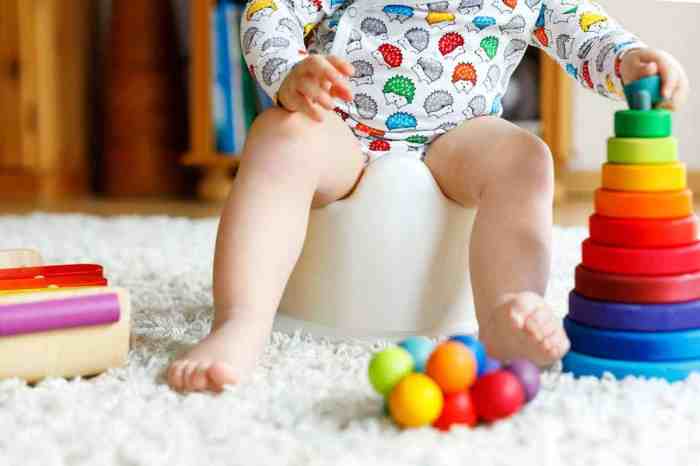Delve into the world of successful potty training with “How to Potty Train a Toddler: 7 Effective Methods for Potty Training Success.” This guide offers a wealth of knowledge to ensure a smooth and efficient potty training journey for both toddlers and parents.
Explore the ideal age to start, the various methods available, and practical tips to navigate this important milestone with confidence.
Introduction to Potty Training

Potty training is the process of teaching a young child how to use the toilet for urination and bowel movements. It is an important milestone in a child’s development as it helps them gain independence and promotes good hygiene habits.
Ideal Age and Signs of Readiness
Most children are ready to start potty training between the ages of 18 months and 3 years old. However, every child is different, so it’s essential to look for signs of readiness such as:
- Showing interest in the bathroom and toilet.
- Staying dry for longer periods during the day.
- Expressing discomfort with dirty diapers.
Benefits of Successful Potty Training
Successful potty training not only benefits the child but also the parents. Some of the advantages include:
- Increased independence and confidence for the child.
- Cost savings on diapers for the parents.
- Less mess and hassle associated with diaper changing.
7 Effective Methods for Potty Training

When it comes to potty training your toddler, there are various methods you can try to achieve success. Each method has its own approach and challenges, so it’s important to choose one that aligns with your child’s personality and your parenting style.
Potty Training Boot Camp Method
The Potty Training Boot Camp method involves dedicating a few days to intensive potty training. This means saying goodbye to diapers completely and focusing on frequent potty trips, positive reinforcement, and consistency. It can be a challenging method initially, but many parents have found success with this approach.
Child-Led Potty Training Approach
Child-Led Potty Training involves allowing your child to take the lead in the potty training process. This means letting them decide when they are ready to start using the potty and following their cues. While this method requires patience and flexibility, it can be effective for children who respond well to autonomy.
Reward-Based Potty Training Strategy
The Reward-Based Potty Training Strategy involves using incentives such as stickers, treats, or small toys to motivate your child to use the potty. This method can be effective in encouraging positive behavior, but it’s important to ensure that the rewards are consistent and aligned with your child’s interests.
Gradual Potty Training Method
The Gradual Potty Training Method involves slowly transitioning your child from diapers to using the potty. This can be done by starting with regular potty breaks, then gradually increasing the time between breaks. While this method may take longer to see results, it can be less overwhelming for some children.
Visual Cues and Reminders Technique
The Visual Cues and Reminders Technique involves using visual aids such as charts, stickers, or a potty training watch to help remind your child to use the potty. These visual cues can be helpful in reinforcing the habit of using the potty regularly.
Team Effort Potty Training Method
The Team Effort Potty Training Method involves getting the entire family involved in the potty training process. This can include siblings, grandparents, or caregivers, who all work together to support and encourage the child in their potty training journey. This method can create a positive and supportive environment for the child.
Nighttime Potty Training Technique
The Nighttime Potty Training Technique focuses specifically on helping your child stay dry through the night. This can involve limiting fluids before bedtime, using nighttime training pants, and creating a consistent bedtime routine. While nighttime potty training can take longer than daytime training, it’s an important step in the overall process.
Tips and Tricks for Potty Training
When it comes to potty training, having a solid routine in place can make all the difference. Here are some practical tips and tricks to help you navigate through this important milestone with your toddler:
Setting a Potty Training Schedule
- Establish a consistent potty schedule based on your child’s natural rhythms.
- Encourage your toddler to use the potty at key times, such as after meals or before bed.
- Use timers or alarms to remind both you and your child when it’s time for a potty break.
Using Positive Reinforcement
- Praise and reward your child for successful potty trips to reinforce good behavior.
- Consider using stickers, small treats, or a potty chart to track progress and celebrate achievements.
- Stay positive and encouraging even during accidents to keep your toddler motivated.
Overcoming Common Potty Training Pitfalls
- Avoid pressuring or shaming your child, as this can lead to resistance and setbacks.
- Be patient and understanding, as every child learns at their own pace.
- Stay consistent with your approach and remain calm in the face of challenges.
Handling Setbacks and Maintaining Patience
- Expect setbacks and accidents to happen, and be prepared to handle them with grace.
- Remain calm and offer reassurance when accidents occur, focusing on the progress made so far.
- Take a step back if needed and revisit the basics before moving forward again.
Final Review
In conclusion, mastering the art of potty training is a crucial step for every toddler. By implementing the 7 effective methods Artikeld here, both parents and children can experience a successful and stress-free potty training journey.